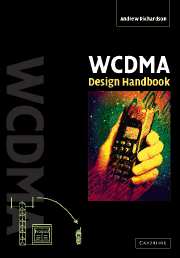Book contents
- Frontmatter
- Dedication
- Contents
- Preface
- Acknowledgements
- List of abbreviations
- 1 Introduction
- 2 WCDMA in a nutshell
- 3 Spreading codes and modulation
- 4 Physical layer
- 5 RF aspects
- 6 Chip rate processing functions
- 7 Symbol rate processing functions
- 8 Layer 2 - medium access control (MAC)
- 9 Layer 2 - RLC
- 10 PDCP and BMC protocols
- 11 Layer 3 - RRC
- 12 Measurements
- 13 NAS
- 14 Idle mode functions
- Appendix
- References
- Index
14 - Idle mode functions
Published online by Cambridge University Press: 05 October 2013
- Frontmatter
- Dedication
- Contents
- Preface
- Acknowledgements
- List of abbreviations
- 1 Introduction
- 2 WCDMA in a nutshell
- 3 Spreading codes and modulation
- 4 Physical layer
- 5 RF aspects
- 6 Chip rate processing functions
- 7 Symbol rate processing functions
- 8 Layer 2 - medium access control (MAC)
- 9 Layer 2 - RLC
- 10 PDCP and BMC protocols
- 11 Layer 3 - RRC
- 12 Measurements
- 13 NAS
- 14 Idle mode functions
- Appendix
- References
- Index
Summary
In this chapter we consider the actions of the UE when it does not have an active radio connection (RRC idle mode state) and also when it is in certain RRC connected mode states (CELL_PCH, URA_PCH and CELL_FACH). For historical reasons, these actions are generally referred to as the idle mode procedures; here we follow the same terminology but add comments where required for the applications of the procedures to the other states.
In the idle mode there are two closely related topics that we need to consider together and which interrelate with one another. These topics are the idle mode substate machine and the idle mode procedures. The idle mode substate machine defines the different states that the UE may be in, the potential transitions between these states and the reasons for being in the states and making the transitions between states. The idle mode procedures define the set of actions that are undertaken by the UE, the outcome of which drives the transitions between the different states in the state machine.
Now, the idle mode procedures and the idle mode substates span the NAS and the AS. Aspects of the procedures and substates apply to both the AS and NAS and so we will consider these in turn. The NAS procedures and substates relate specifically to the activities of the MM sublayer, which is considered in Chapter 13. These NAS issues are further separated into the CS domain activities (MM entity) and the PS domain activities (GMM entity).
- Type
- Chapter
- Information
- WCDMA Design Handbook , pp. 508 - 541Publisher: Cambridge University PressPrint publication year: 2005



